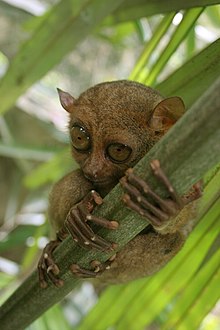| Philippine tarsier | |
|---|---|

| |
| Scientific classification | |
| Domain: | Eukaryota |
| Kingdom: | Animalia |
| Phylum: | Chordata |
| Class: | Mammalia |
| Order: | Primates |
| Suborder: | Haplorhini |
| Family: | Tarsiidae |
| Genus: | Carlito Groves & Shekelle, 2010 |
| Species: | C. syrichta
|
| Binomial name | |
| Carlito syrichta | |

| |
| Geographic distribution of Philippine tarsier | |
| Synonyms | |
| |
The Philippine tarsier (Carlito syrichta), known locally as mawumag in Cebuano and other Visayan languages, and magô in Waray, is a species of tarsier endemic to the Philippines. It is found in the southeastern part of the archipelago, particularly on the islands of Bohol, Samar and Leyte. It is a member of the approximately 45-million-year-old family Tarsiidae, whose name is derived from its elongated "tarsus" or ankle bone. Formerly a member of the genus Tarsius, it is now listed as the only member of the genus Carlito, a new genus named after the conservationist Carlito Pizarras.
Its geographic range also includes Maripipi Island, Siargao Island, Basilan Island and Dinagat Island.[1] Tarsiers have also been reported in Sarangani, although they may be different subspecies.
- ^ a b Shekelle, M. (2020). "Carlito syrichta". IUCN Red List of Threatened Species. 2020: e.T21492A17978520. doi:10.2305/IUCN.UK.2020-3.RLTS.T21492A17978520.en. Retrieved November 19, 2021.
